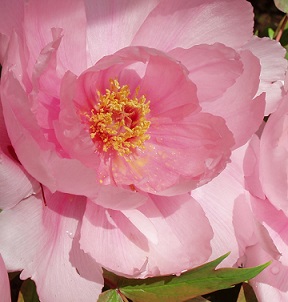Floral Diagrams Floral Formulae
 These are ways of representing a flower structure. Both of these are constructed by studying a flower, identifying the various parts (eg. sepals, petals, anthers etc), then representing those components of the flower either graphically or numerically.
These are ways of representing a flower structure. Both of these are constructed by studying a flower, identifying the various parts (eg. sepals, petals, anthers etc), then representing those components of the flower either graphically or numerically.
A Floral Formula is a series of symbols or abbreviations representing flower parts, each followed by a number that indicates the number of individual parts of that component.
“C” for example, is the symbol for corolla (ie. petals) and “A” is a symbol for androecium (ie. stamens); hence a floral formula that includes “C(5), A(9)” would indicate that this flower has 5 petals and 9 stamens.
A floral diagram is drawn over a series of imaginary circles, each one inside of the next. At the centre is a representation of the gynoecium (ie. female structure). This is surrounded by the androecium (ie. male structures), and in turn, the androecium is surrounded by the corolla (ie. petals) and the corolla by the sepals. The drawing will show both the number of each part and their relative position in the flower.
Why?
There are various reasons for creating floral diagrams and floral formula. They are tools for conveying clearly and simply, the characteristic differences between different types of flowers, but they are also a useful exercise for studying and learning plant taxonomy. By working through the process of creating floral diagrams and formula, you are forced to observe and identify details that differentiate one plant from another, and that reinforces your powers of observation and your understanding of differences between different plants.
FLORAL FORMULA
There are many different symbols which may be used in floral formula, however a simple floral formula can be created in most situations, using far fewer symbols. For the purpose of learning the basics of writing floral formula, we will limit the symbols used here to the following:
Br = Bracteate characteristics
K = Calyx (sepals)
C = Corolla (Petals
A = Androecium (stamens)
G = Gynoecium (carpels) A “G” that is not underlined has an inferior ovary
G = A “G” that is underlined has a superior ovary
The parts of any whorl in a flower can be either free or fused; for example there may be 4 petals which are joined to each other at the bottom (ie fused); or they may be totally separate to each other.
If the Petals are free the number is represented without brackets, but fused petals are represented with the number bracketed.
ie. K4 represents 4 free petals in a whorl; and K(4) represents 4 fused petals in a whorl.